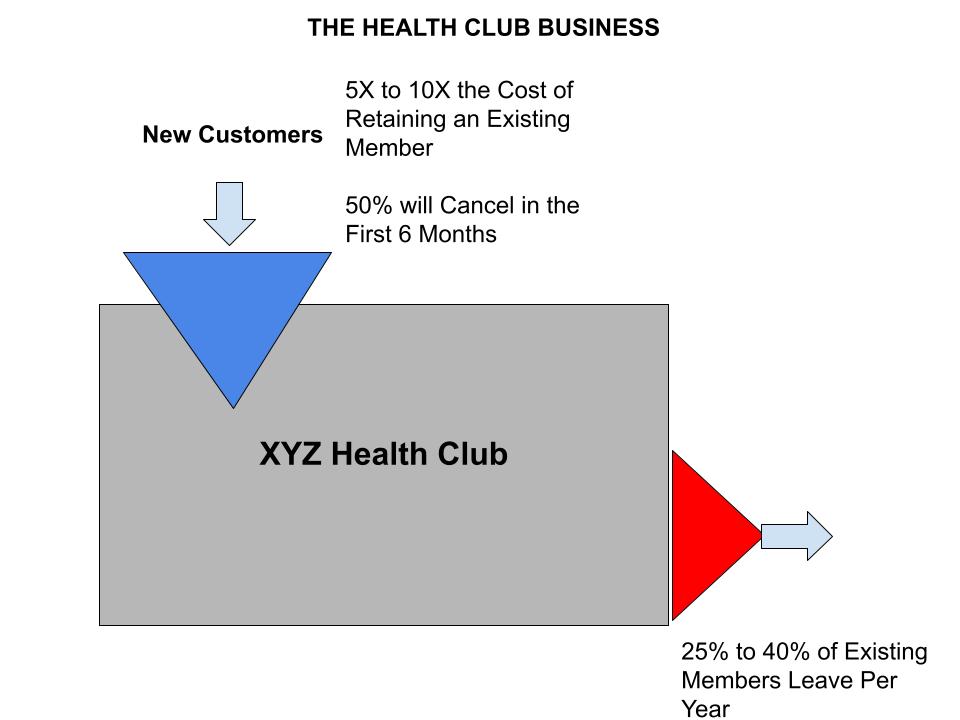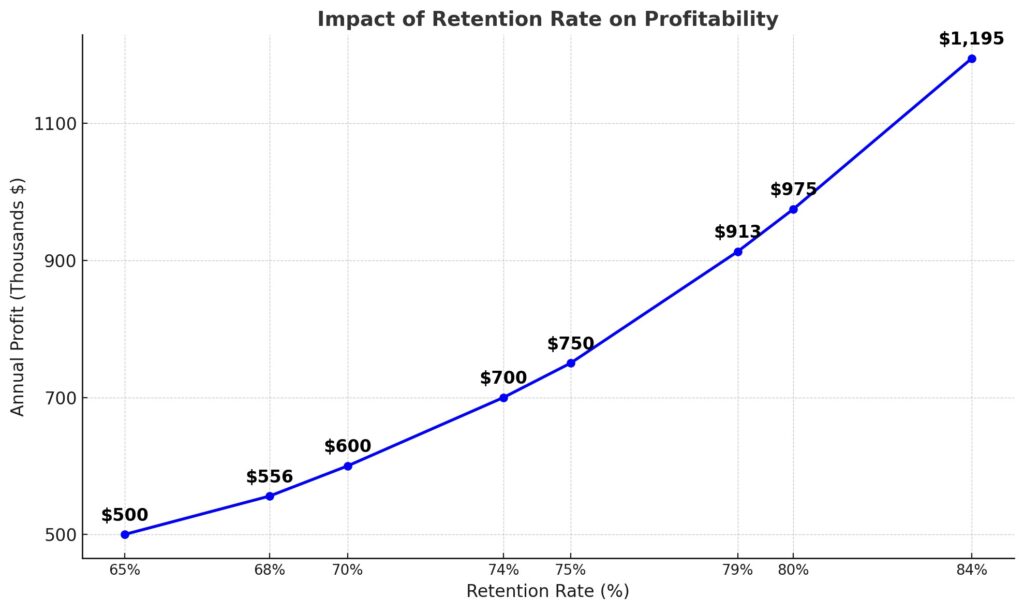
In the fitness industry, profit is achieved by increasing member satisfaction which translates into higher retention rates. The retention rate is the percentage of members that still belong to a club 12 months later. This percentage will range from 60% to 75% with boutique clubs occasionally registering higher. A health club must constantly replace the members that they lose from attrition. The graphic below illustrates the constant plight of the health club owner.

The retention rate is the main determinant of a health club’s profits. A very important fact about this relationship is that a change in the retention rate has an exponential effect upon changes in profits – this relationships holds for changes in retention rates in either direction. The chart below is for a fictional health club with a 60% retention rate that is earning $500,000 in annual profits. Note how profits expand for similar increases in the retention rate as the retention rates increase. At 69% an increase to 70% in the retention rate increases profits by approximately $24K, from 74% to 75% yields $50K and from 79% to 80% brings in an additional $62K


Many strategies to increase the retention rate have been around for decades with some modifications for new technologies and lifestyle modifications. The members, however, are thought of exactly as they were 50 years ago or more. This is what caps most clubs’ retention rates in the low 70s, if they are even able to achieve that. A new understanding of human behavior informed by cognitive science, psychology and behavioral economics is required to move past these artificial ceilings in retention rates.
Economics No Longer Assumes Purely Rational Behavior
When the founder of this company studied Economics at The University of Chicago in the mid-1980s, he was taught that the core assumption of economics was that humans act rationally. This foundation started to crack due to the work of many but most notably are Herbert Simon, Richard Thaler, Amos Tversky and Daniel Kahneman. Kahneman is the only psychologist to ever be awarded a Nobel Prize in Economics. His work challenged the assumption of human rationality in economic models, leading to the development of behavioral economics.
“Kahneman is the most influential psychologist since Sigmund Freud… No one else has had such a broad impact on so many fields.” — Christopher Chabris, cognitive psychology professor (Union College) and author
“Daniel Kahneman is among the most influential psychologists in history. His work has reshaped social psychology, cognitive science, the study of reason and of happiness, and behavioral economics” – Steven Pinker, Harvard University psychologist and best-selling author
In his best-selling book “Thinking, Fast and Slow”, Kahneman described two modes of thinking:
System 1: Fast, automatic, and intuitive thinking (95% of our decisions)
System 2: Slow, deliberate, and analytical thinking (5% of our decisions)
Joining a health club is a system 2 decision. Canceling one’s membership is a system 1 decision (Watts, 2012).
Cognitive Biases and the Two Selves Framework
Kahneman also introduced the concept of people being comprised of two selves, the experiencing self and the remembering self. His research also advanced the understanding of cognitive biases in decision-making processes. A cognitive bias is a systematic pattern of deviation from rationality in human thinking. It occurs because the brain uses mental shortcuts, or heuristics, to process information quickly. They help us make sense of the world efficiently but can lead to irrational choices. Roughly 200 cognitive biases have been identified at this point.
The peak–end rule is a psychological heuristic suggesting that people judge an experience largely based on how they felt at its most intense moment (the peak) and at its conclusion (the end), rather than considering the experience in its entirety. Because most trips to a health lack a peak experience, how the visit ends will dominate how the entire trip is recalled. Member satisfaction is a weighted summation of all of the member’s experiences. It is imperative, for the sake of profits, that negative experiences at the end of members’ visits are eliminated.
A trip to the health club can be thought of as three separate events:
The initial usage of the locker room
Some fitness activity
The final usage of the locker room